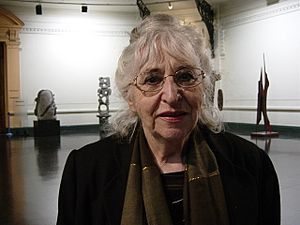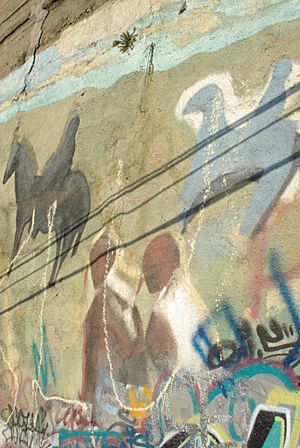Gracia Barrios facts for kids
Quick facts for kids
Gracia Barrios
|
|
|---|---|

2007
|
|
| Born |
Gracia Barrios Rivadeneira
27 June 1927 Santiago, Chile
|
| Died | 28 May 2020 (aged 92) |
| Alma mater | University of Chile |
| Occupation | Painter |
| Spouse(s) | José Balmes |
| Children | Concepción Balmes |
| Parents |
|
| Awards | National Prize for Plastic Arts (2011) |
Gracia Barrios Rivadeneira (born June 27, 1927 – died May 28, 2020) was a famous Chilean painter. She won the important National Prize for Plastic Arts in 2011. This award celebrates the best artists in Chile.
Contents
Biography of Gracia Barrios
Gracia Barrios was born in Santiago, Chile. Her father was Eduardo Barrios, a writer who won the National Prize for Literature. Her mother, Carmen Rivadeneira, was a pianist. Gracia loved art from a young age.
Early Life and Education
She started taking art classes early on. She learned from the painter Carlos Isamitt. While still in high school, she went to evening art classes. These were held at the School of Fine Arts at the University of Chile.
After finishing high school, Gracia studied at the same university from 1944 to 1949. Her teachers included Augusto Eguiluz and Carlos Pedraza. Pablo Burchard was another important teacher who greatly influenced her painting style.
Teaching Career and Grupo Signo
Gracia Barrios began teaching art in 1953. She worked at her old university as an assistant. She taught drawing until 1973.
In the 1960s, she joined a group called Grupo Signo. This group wanted to try new ways of painting. They moved away from older styles like post-impressionism. They also wanted to paint on things other than just easels. Other artists in this group were Alberto Pérez, José Balmes, and Eduardo Martínez Bonati. In 1962, Grupo Signo showed their art in Spain and France.
Life in Exile and Return
After the 1973 Chilean coup d'état, Gracia Barrios had to leave Chile. She went to France with her husband and daughter. They lived outside Chile for about ten years.
When she returned, Gracia taught at the Catholic University. This was from 1983 to 1986. Later, in 1994, she became a professor at Finis Terrae University. She stopped teaching some years later. She once said that art used to be more open to everyone. She felt that later, art became more about money and social status.
National Prize for Plastic Arts
In 2011, Gracia Barrios received the National Prize for Plastic Arts. The people who chose her said her art showed "an endless search for what it means to be human." They also noted how her work explored "the connection between people and their life stories."
Gracia Barrios's Art Work
Gracia Barrios's art often focused on "human activities in everyday life." At first, she painted in a figurative style. This means her paintings looked like real people or objects.
Changing Art Style
Around the 1960s, she changed her style. She moved towards a more informal way of painting. She called her new style "informal realism." In this style, she showed people through large shapes of bodies, heads, and mothers. She also showed a strong connection to the people and land of the American continent. Some of the serious topics she painted about included war, poverty, and being forced to leave one's home.
Materials and Exhibitions
Besides using oil and acrylic paints, Gracia Barrios also tried new things. She used natural materials like earth and clay. This helped her make her artworks feel more solid and real.
Her paintings have been shown in many countries. These include Spain, France, Germany, Brazil, and Japan. Her art can be found in museums in Chile and Europe. Some of these are the Barcelona Museum of Contemporary Art and the André Malraux Museum in Le Havre.
Personal Life
In 1943, Gracia Barrios met another painter named José Balmes. They met while taking art classes at the University of Chile. The poet Enrique Lihn introduced them. Gracia and José got married in 1952. They had a daughter named Concepción Balmes, who also became a painter.
Gracia Barrios passed away on May 28, 2020. She was 92 years old.
Awards and Recognitions
- 1957 – First Prize for Drawing, 68th Official Salon, Santiago
- 1958 – Second Prize for Painting, 69th Official Salon, Santiago
- 1959 – Second Prize, 70th Official Salon, Santiago
- 1964 – Second Prize, Esso Salon, Museum of Contemporary Art, University of Chile, Santiago
- 1965 – First CRAV Prize for Painting, Santiago
- 1965 – Second Prize, Painting, Esso Salon for Young Artists, Pan American Union, Washington, United States
- 1966 – First Prize for Painting, 76th Official Salon, Santiago
- 1968 – Second Prize, American Biennial of Quito, Ecuador
- 1971 – Prize of Honor of the 15th Ñuñoa Salon, Santiago
- 1988 – Achievement Award, Mural of the Worker's Hospital, Santiago
- 1996 – Municipal Art Prize, Municipality of Santiago
- 2011 – National Prize for Plastic Arts
See also
 In Spanish: Gracia Barrios para niños
In Spanish: Gracia Barrios para niños


